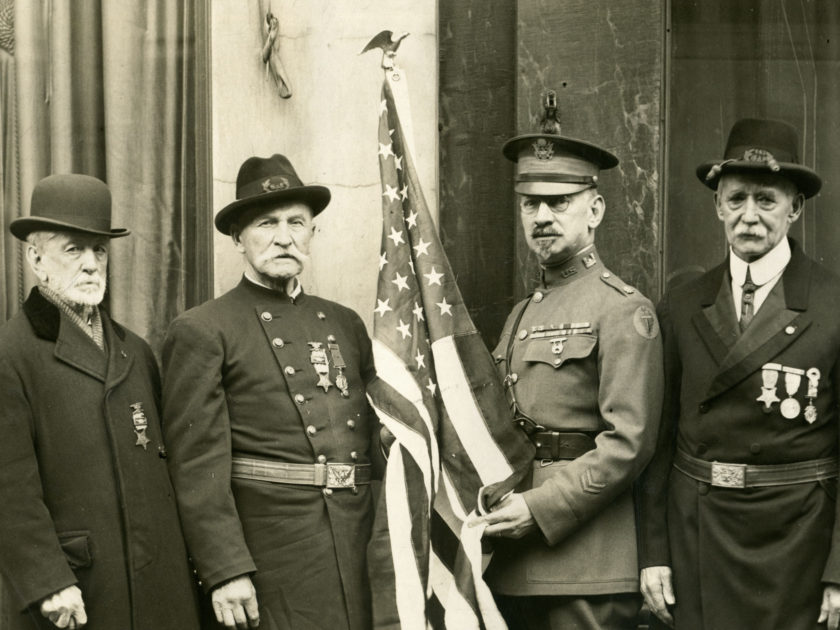A significant number of Civil War veterans lived to see their sons, grandsons and others in their extended families grow to maturity.
In 1917 and 1918, many of these former Blue and Gray soldiers watched their young men march off to participate in a global conflict involving large European militaries locked in a dreadful war of attrition. These American soldiers, 4.7 million strong, were dubbed doughboys, a reference to their status as new recruits with no practical military experience. Many encountered their first sting of battle against the Imperial German Army in the trenches of France. The Great War battles at Cantigny, Chateau-Thierry, Belleau Wood and St. Mihiel on the Western Front became, for many, their Shiloh, Gettysburg, Vicksburg and Petersburg. When the final casualty list of World War I was tallied, more than 116,000 doughboys had perished—a staggering number, though a fraction of the three-quarters of a million soldiers who died in the Civil War.
Black and white photographs and grainy film footage of the conflict illustrate the horror and brutality of armed conflict. The portraits featured here, far away from the lines of battle, reflect a fraternal and patriotic bond that doughboys shared with their Civil War counterparts, Billy Yank and Johnny Reb.

Loyalty to a Commander
There can be no doubt that the astute Gen. John J. Pershing observed the Medal of Honor worn by the veteran with whom he exchanged a handshake in this candid press photograph. But it is not known if the general ever learned how the old soldier, Le Roy Williams, received it. Williams, a sergeant in the 8th New York Heavy Artillery, survived a murderous charge that decimated his regiment at the Battle of Cold Harbor on June 3, 1864. Among those killed was his colonel, Peter A. Porter, who reportedly fell beneath the enemy’s guns. When volunteers were called to retrieve the body of their commander, Williams stepped forward. He led a detail of four men and brought back Porter’s remains under heavy fire. Williams was awarded the Medal in 1898, and died at age 85 in 1930.

“Paul & Grandpa, July 1917”
Countless grandfathers and grandsons played out this scene, left, in yards, on porches and elsewhere across the country after Congress declared war against Germany on April 6, 1917. The young man pictured here, known only as Paul, was an early volunteer. His fate as a soldier is unknown. There can be no doubt his grandfather, a survivor the Civil War, wished his grandson a similar outcome. Yet both men understood that fighting for the flag could lead to the ultimate sacrifice.

Western Veterans
The Civil War veteran, seated with a World War I era sailor and soldier, is decked out in his G.A.R. finery. In one portrait, he wears a ribbon inscribed California-Nevada. Posts from the two states gathered together for encampments and other activities during the organization’s heydays.

Surrounded by Comrades
The faces of two G.A.R. members centered in a large group of soldiers and are filled with pride and confidence that comes with victory. The man on the left is Conrad Homan of the 29th Massachusetts Infantry. On July 30, 1864, at the Battle of the Crater, Cpl. Homan fought his way through enemy lines with the regimental flags after all but one of the color guard had been killed or captured. He ended the war as a first lieutenant and received the Medal of Honor for The Crater in 1869. This group photograph was taken about 1919, the 50th anniversary of Homan’s receipt of the Medal. The old veteran passed away three years later at age 81. The old veteran seated next to Homan is not known.

An Empire State Officer and a Marine
Standing ramrod straight, 80-year-old Isaac Jelliff poses with Marine Fred L. Wehrhan. Jelliff served as an officer in the 56th and 143rd New York infantries from 1861 to 1865, and afterward was an active member of his G.A.R. post in Sullivan County, N.Y. His relationship to Wehrhan is not known.


Col. Pattee’s Old Soldier Fiddlers
Soon after the turn of the century, Civil War veteran John Artimus Pattee promoted himself to colonel and recruited other veterans for a novel Vaudeville act. His “Old Soldier Fiddlers,” dressed in blue and gray, headlined at various veterans’ gigs, and also to audiences in theaters and on radio. The Philadelphia Inquirer noted that Pattee’s distinctive “voice when calling out each tune in the fashion of the country fiddler won for him a warm spot in the hearts of radio listeners” on New York’s WEAF, which later became WNBC.
For more than a decade, at least 10 men played in the band at one time or another. In this 1918 promotional shot, national unity is the theme. Pattee, to the left and dressed in blue with three stars on his collar, served in the 24th Michigan Infantry. He later transferred to the “Iron Brigade Battery” of the 4th U.S. Artillery. He shakes hands with George Patterson. Though attired in a suit of gray, Patterson was a member of the 8th Pennsylvania Cavalry. The handshaking veterans on the right are “Major” E.W. McIntosh, affiliation unknown, and G.H. Hamersley, reported to have served in the Virginia State Militia. The doughboy in the center is believed to be Pattee’s son, John, Jr.
The band dissolved around 1920 due to health issues, but reformed with Pattee and McIntosh the following year, as shown in this promotional photograph. The “Old Soldier Fiddlers” passed from the scene forever when Pattee died in 1924 at age 80. He is buried in Arlington National Cemetery.
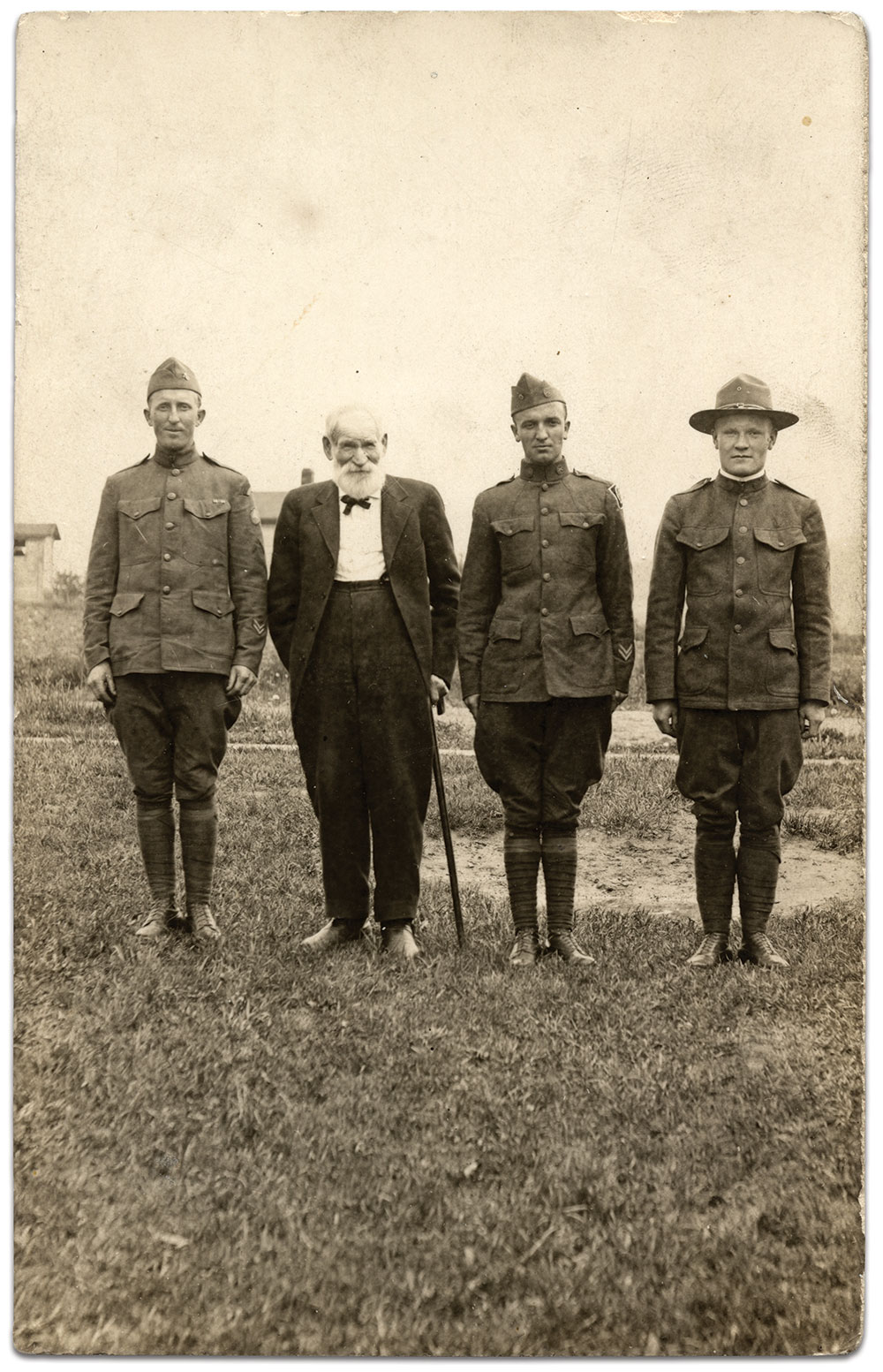
West Virginia Veterans
Standing tall with the aid of a cane, William S. Bailey poses with his doughboy grandsons. Virginia born and Union loyal, Bailey began his Civil War service in a dragoon company that became part of the 1st and 2nd West Virginia cavalries. Captured at Frederick, Md., on Sept. 12, 1862, and paroled the next day, he survived his military experience. He worked in the coke ovens after the war and died in 1925.
His eldest grandson, George William Kessler (1888-1942), stands to the left of Bailey. Kessler served in the 166th Infantry and suffered a shrapnel wound in his right shoulder on July 15, 1918, at the Second Battle of the Marne—the last major German offensive along the Western Front. Right of Bailey is Harry Franklin Kessler (1892-1954), who served in Europe with Battery E of the 320th Field Artillery. On the far right stands David Ritchie (1896-1967), who remained stateside during the war.

The uniform of this anonymous major with a hand on the folds of the Stars and Stripes provides clues to his identity. He sports a shoulder patch that marks his membership in the 36th Texas Division and a brass engineer’s castle on his collar. The double chevrons near his cuff indicate his two six-month tours of duty overseas. An array of decorations pinned to his chest include what appears to be a Purple Heart, marksmanship medal, ribbons for Mexican Border Service and World War I victory.
The Grand Army of the Republic veterans pictured here likely belonged to the same post. The men standing on each side of the major wear the unique veteran’s medal of Brooklyn, N.Y. The extra bars attached to the G.A.R. membership medals worn by the two veterans to the left of the major indicate that they were officeholders of their post.
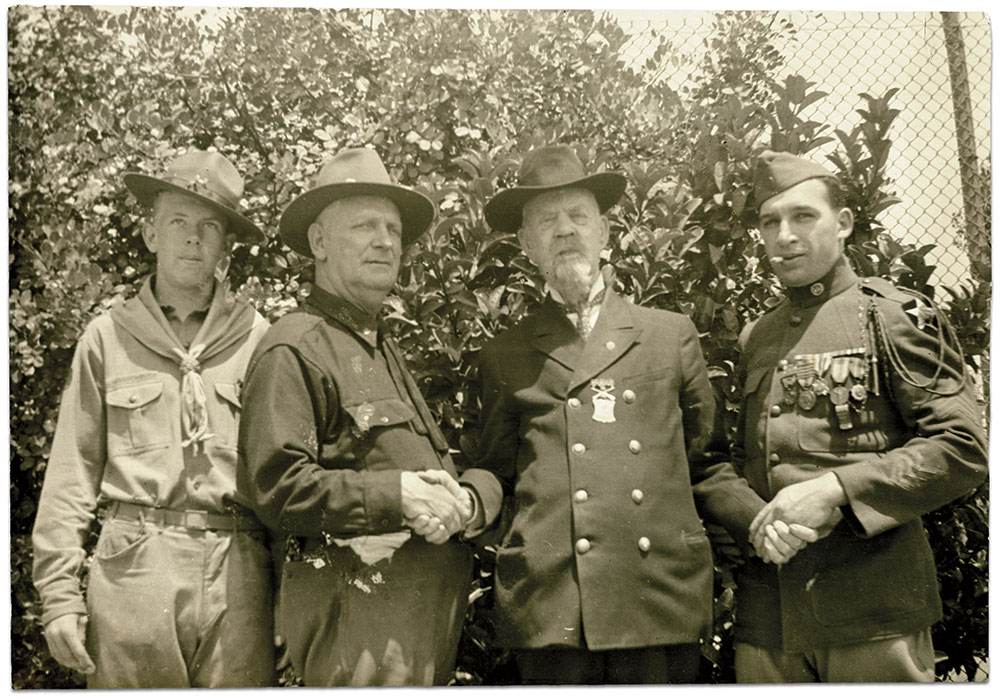
Handshake Across Time
A grand old man from the Union army shakes hands with a 2nd Infantry Division doughboy and a Spanish-American War veteran. The Boy Scout looking on may have wondered if and when he would receive the call to defend his country.
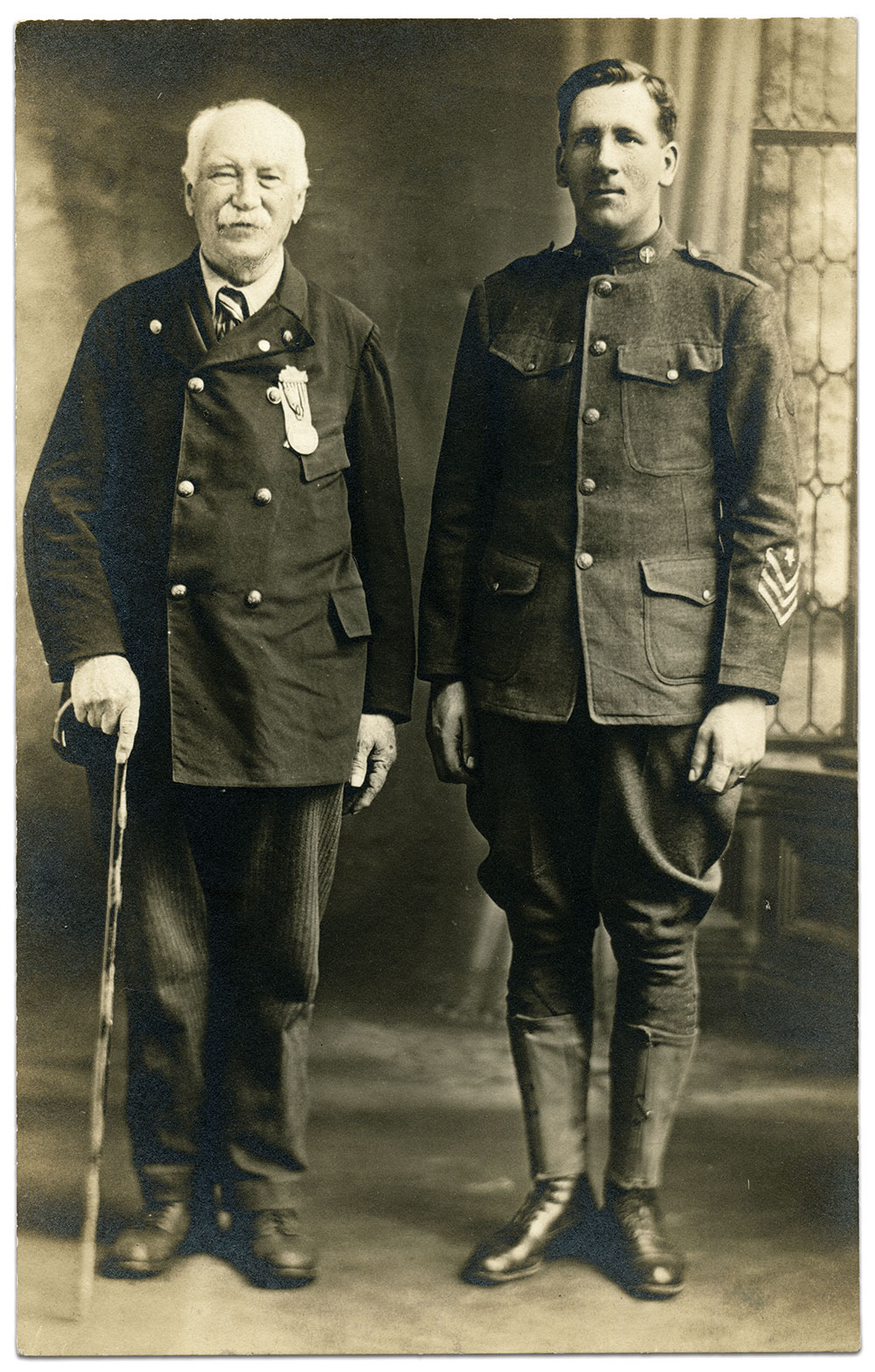
Andersonville Survivor with an Overseas Veteran
Charles Edward Whitney was at least 75 years old when he posed with the young veteran standing by his side. Whitney had served in the 154th New York Infantry, and fell into Confederate hands twice during the Civil War—at Chancellorsville in 1863 and Rocky Face Ridge in 1864. His second capture ended in a trip to Andersonville. Here he wears the Andersonville survivor’s medal presented to veterans who attended the dedication of the New York State monument there in 1914. Whitney lived until 1923. The name of the World War I soldier is not known. But his uniform insignia provides clues to his identity. The chevrons on his lower sleeve indicate three tours of duty overseas. The purpose of the star above the chevrons is not exactly known, though some sources suggest it was awarded to the first 100,000 doughboys to arrive in Europe. The disk on his collar appears to be the propeller and wings of the U.S. Army Air Service, a precursor to the army’s Air Corps and U.S. Air Force.

Father and Son Infantrymen
Archie Franklin Fears, a lanky six-footer with a hint of a smile, stands beside his father, James Monroe Fears, in this 1917 portrait. Archie, 23, was drafted in the summer of 1917, assigned to the 154th U.S. Infantry and spent a year in France with the 39th Division. He returned home in August 1919 and lived until 1966. His father enlisted in the 27th Mississippi Infantry in the summer of 1861, and served four years in the Confederate army. His military career ended on April 26, 1865, when Gen. Joseph E. Johnston surrendered to Maj. Gen. William T. Sherman in Durham, N.C. James returned to his home in Amory, Miss., after the war, and fathered 13 children with two wives. Archie, his second youngest child, was the eighth of nine children born to James and his second wife, Clara. (He had four additional children with his first wife, Lucy, who died young.)
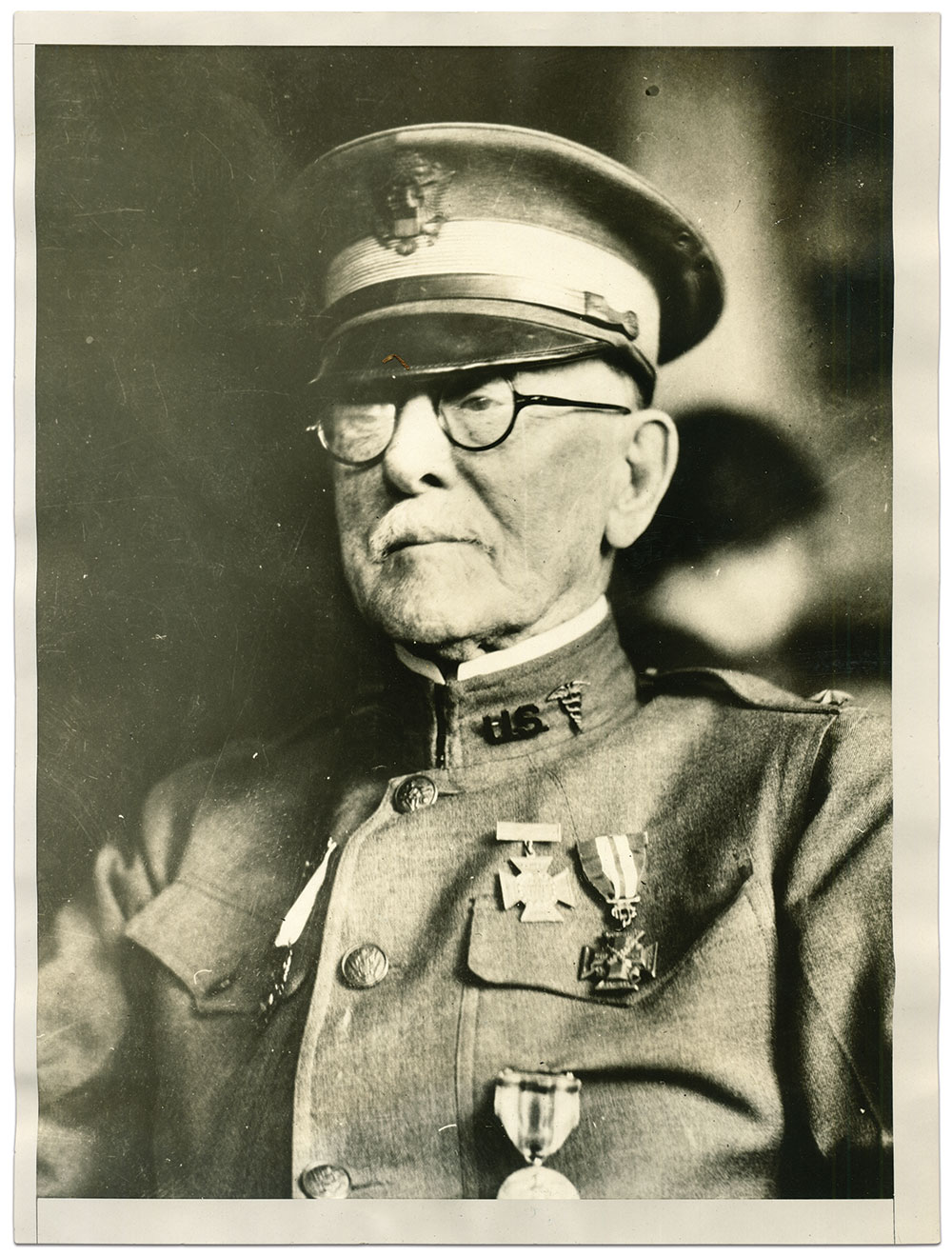
Alabama Artilleryman, Chief Surgeon
William West Grant was all of 16 years old when he left the family plantation in Russell County, Ala., and joined the Confederate army. He enlisted in an artillery battery attached to the brigade commanded by Brig. Gen. James H. Clanton. During his 16 months in uniform, Grant participated in engagements at Mount Hope Church and Columbus, Ga. After the war, he studied medicine in Philadelphia and New York, and graduated in 1868.
Dr. West went on to enjoy a reputation as a trusted physician. He had practiced in several Western and Midwestern states, including Davenport, Iowa, where he was credited with having performed the first appendectomy in 1883. Though this claim turned out to be false, Grant was an innovative surgeon and a specialist in gynecology. He brought his considerable talents to the army, where he served in various capacities, including Chief Surgeon at Fort Logan, Colo., with the rank of major, during World War I. The United Daughters of the Confederacy presented him with a medal in honor of his long service. The Daughters believed West to be the only former Confederate to serve during the Great War. He lived until 1934.
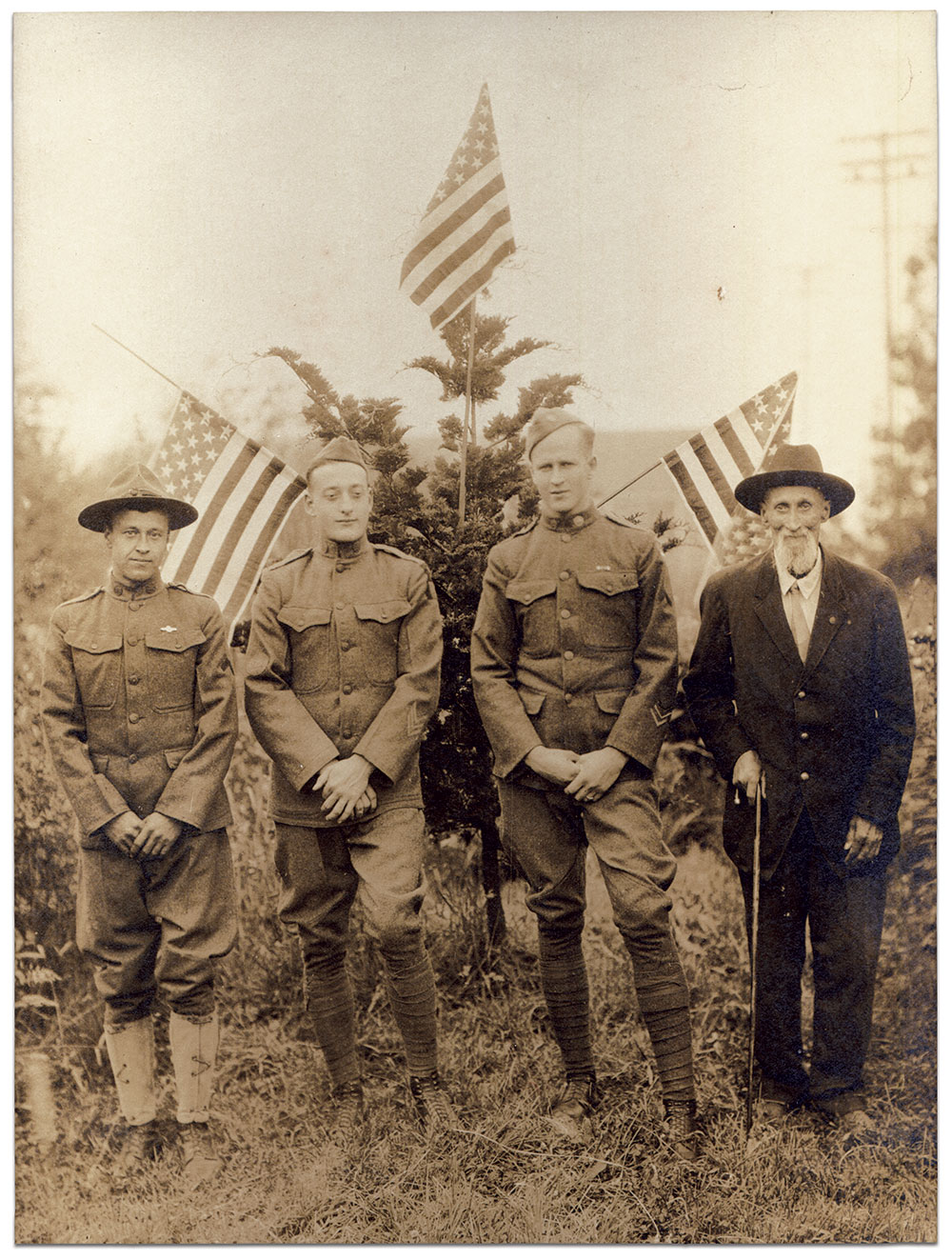
Washington State Volunteers
After President Woodrow Wilson asked Congress to declare war on Germany, the trio of Washington-born doughboys pictured here enlisted in the army. They are, from left to right, Pfc. Durley Leroy Hamilton (1892-1964), who served in the Coast Artillery Corps (C.A.C.) in California; Pfc. Jefferson Koch “Jeff” Cressey (1897-1971), who was stationed in France for 18 months with the 13th Company, 5th Battalion, 20th Engineers; and Cpl. Purley Hamilton (1894-1989), the younger brother of Durley, who served in Company A, Motor Water Tank Train, 302nd Engineers, and received the Victory Medal for his participation in the 1918 Meuse-Argonne Offensive.
Standing with them is Pfc. Cressey’s grandfather, William Henry Harrison Cressey (1839-1921). Born and raised in Pennsylvania, he responded to President Abraham Lincoln’s call for troops in 1861 by enlisting in the Keystone State’s 20th Infantry for a three-month term. Two years later, in 1863, he responded to Gov. Andrew Curtin’s request for emergency troops to defend the state against the invading Army of Northern Virginia. Cressey served in the 40th Militia Infantry, but saw no hostile action. After the war, he married and started a family that grew to include eight sons and a daughter. His third son, George Good Cressey (1869-1952) was Jeff’s father.
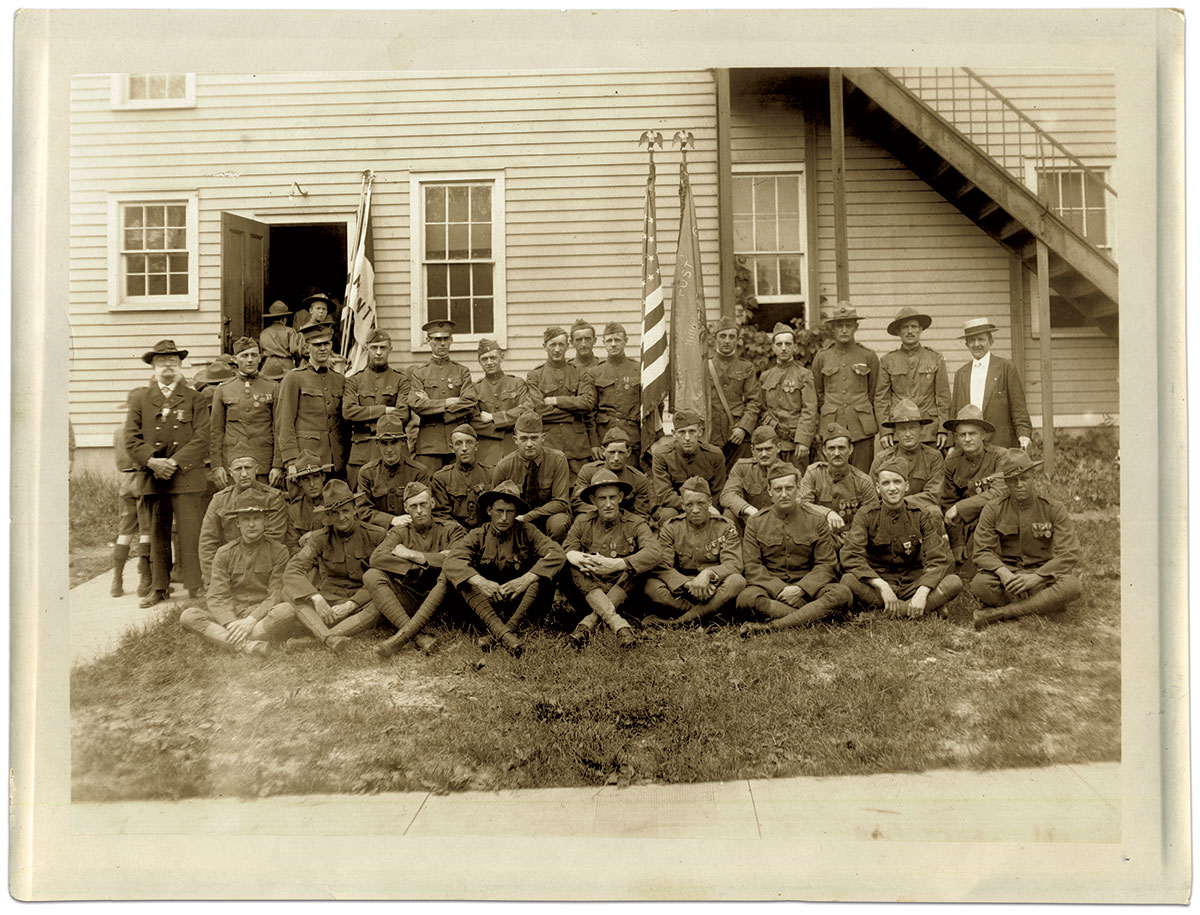
Members of a Veteran’s Post
A group of World War I veterans pose with a lone member of the Grand Army of the Republic. These men may have belonged to the American Legion. Chartered by Congress in 1919, the organization became a powerful force in politics, much like the G.A.R. and the United Confederate Veterans did after the Civil War. The American Legion played a key role in the Serviceman’s Readjustment Act of 1944, popularly known as the GI Bill. The landmark legislation changed the face of higher education.
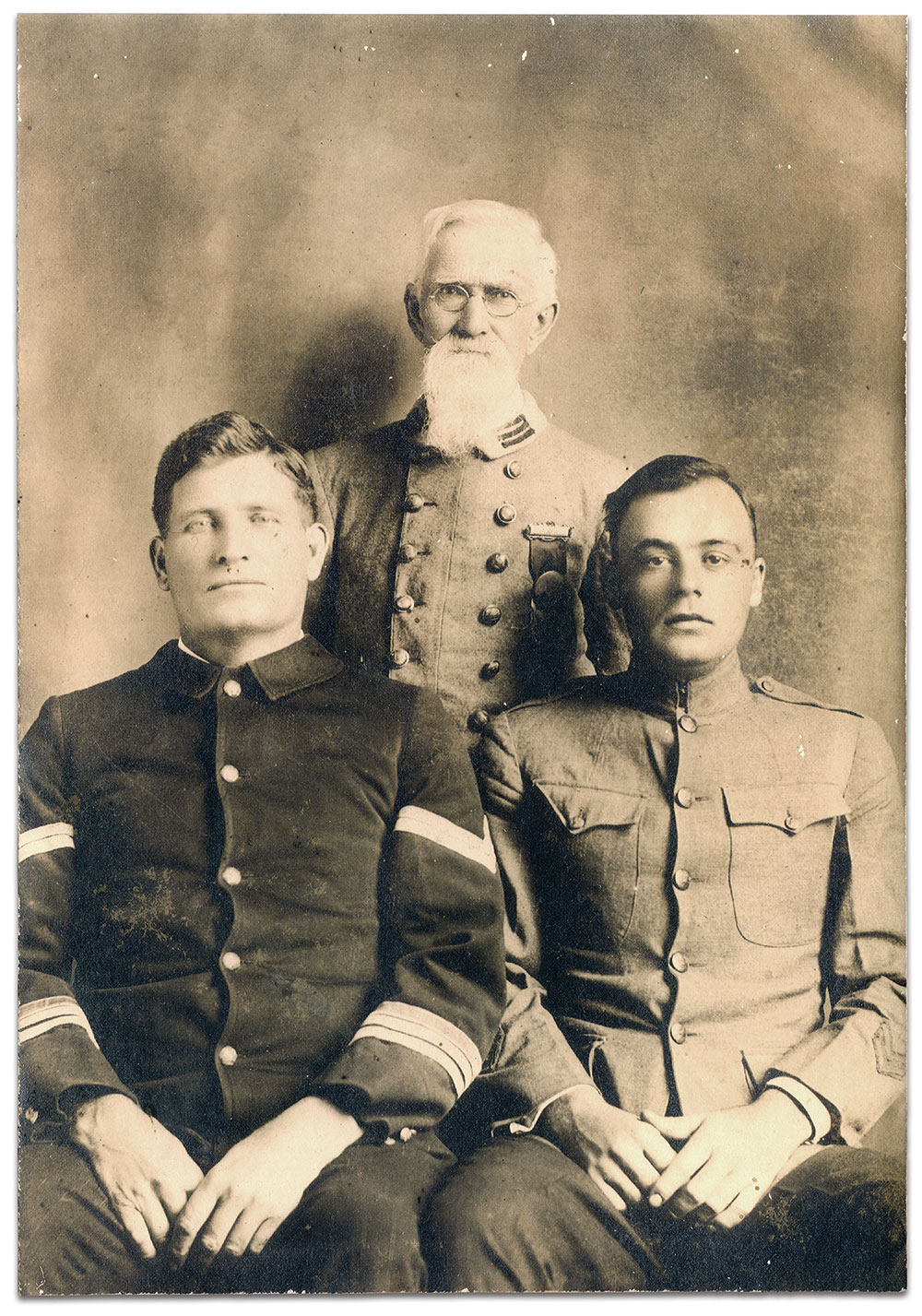
Tennessee Fighters
This trio spans generations of soldiers with connections to the northwestern Tennessee town of Paris. The grand old man of the group is Powhattan Perkins Pullen. Born in Tennessee and known as “Tan” to his friends, he served in the 2nd Kentucky Cavalry (Col. Thomas G. Woodward) from 1862 to 1865. Captured at Cleveland, Tenn., on Nov. 6, 1863, Pullen spent the rest of the war in captivity at Rock Island, Ill., He gained his release on May 28, 1865, after he swore the oath of allegiance to the United States. Active in veteran’s affairs, he lived until 1933. David Ferrell Quillin (1877-1953), seated left, served during the Spanish-American War as a private and corporal in Company D and G of the 1st Tennessee Infantry. John Luke Browning (1894-1968) served two tours of duty overseas during World War I, as evidenced by his chevrons.

Texas Fiddler
Many Confederate veterans in Texas knew Moses Junior “M.J.” Bonner as a tireless man who traveled the Lone Star state to ensure the old soldiers had pensions and other benefits. An Alabama native, he had moved with his family to Texas about 1854, and served in the 12th Texas Cavalry. An African-American man taught Bonner to play the fiddle before the war. In 1911, he won a state fiddling championship, which launched a career as a musician. His reputation as a fiddler and jig dancer—he carried around a wooden platform called “Bonner’s Puncheon” for his performances—led to numerous appearances in person and later on radio. In 1925, Victor records released an album that featured “Capt. M.J. Bonner, the Texas Fiddler.”
Near the zenith of his popularity, he posed with the sergeant and enlisted men pictured here. Bonner died in 1939 at age 92.
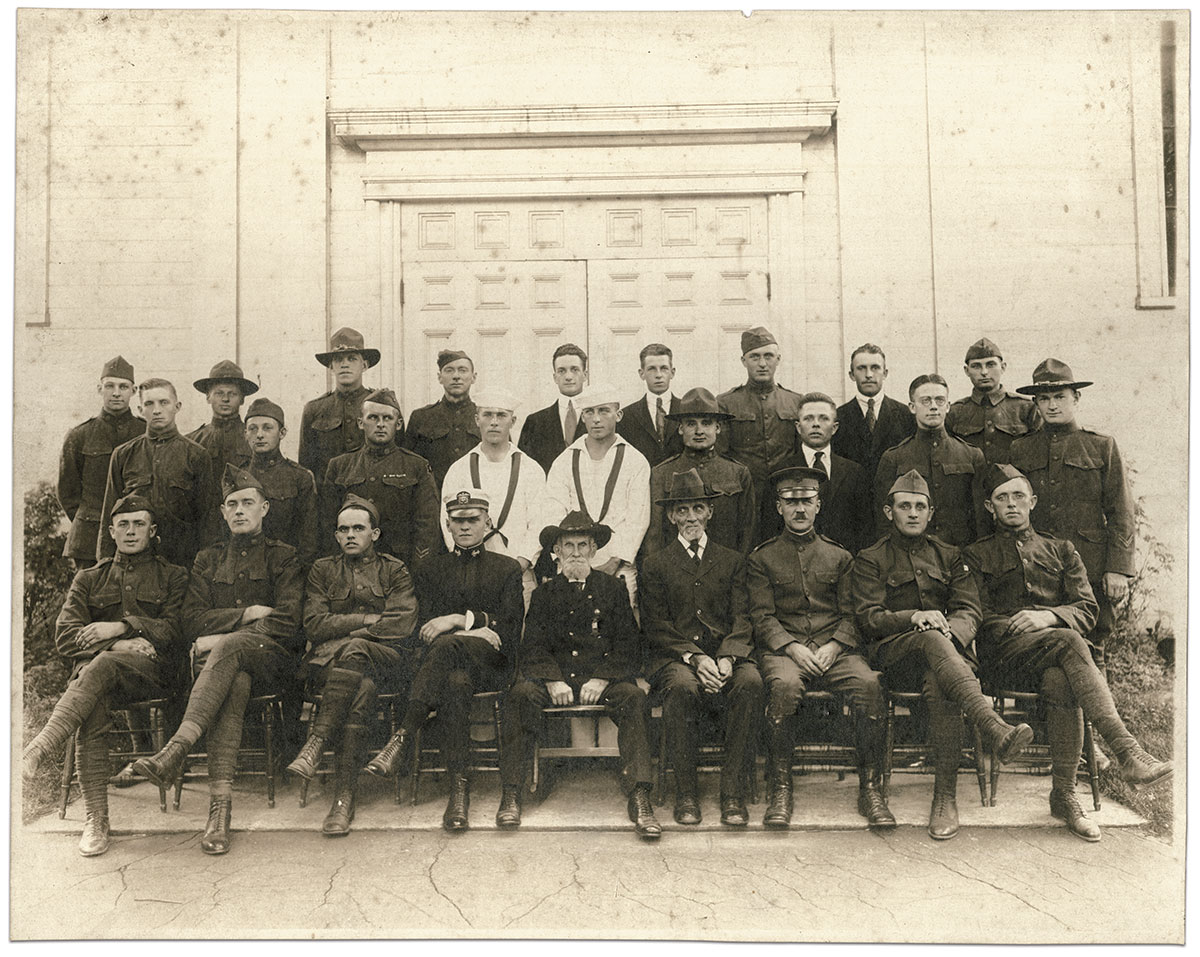
Lone Member of the G.A.R.
A veteran of the Civil War dressed in his G.A.R. uniform sits among a group of soldiers and sailors in this circa 1919 portrait. The presence of overseas chevrons on some coat sleeves and a variety of shoulder insignia suggest that the doughboys served in different units. Odds are this group is the membership of a local American Legion post.

A Military Career that Spanned Three Wars
While other Civil War veterans were content to send their sons and grandsons off to World War I, Walter H. Thomas Jr., was still in uniform. He is pictured here as a first lieutenant in the 8th Massachusetts Infantry, a rank he obtained in September 1918 at age 67. Thomas began his military service 55 years earlier in 1863, when, at age 12, he enlisted as a drummer boy in the 29th Maine Infantry. Appointed an orderly to the regiment’s colonel, George L. Beal, Thomas participated in numerous engagements, including the Battle of Cedar Creek and the Red River Campaign. Discharged in 1866, he went on to serve in the 5th U.S. Artillery and, beginning in 1873, on stints of varied lengths with National Guard units in Maine, New York and Massachusetts. He joined the 8th Massachusetts at some point after 1890 and saw active duty in Cuba during the Spanish-American War.
The medals pinned to his uniform pay tribute to his varied military career and his longevity as a soldier. They include, on the top row, a Massachusetts Volunteer Militia Expert Cross with a Grand Army of the Republic badge, a Spanish War Veterans medal and a Veterans of Foreign Wars medal, with a bar indicating an elected position in that organization. The second row includes medals that honor Civil War campaigns, Army of Cuban Occupation, Spanish-American War service, World War I victory Medal and service in the Massachusetts Volunteer Militia. All of the medals were earned, except the World War I Victory Medal, as he was not activated for federal service during this period. Upon his death in 1926, he was, according to an obituary, “One of the most widely known military figures in New England.” Thomas was 75.
SPREAD THE WORD: We encourage you to share this story on social media and elsewhere to educate and raise awareness. If you wish to use any image on this page for another purpose, please request permission.
LEARN MORE about Military Images, America’s only magazine dedicated to showcasing, interpreting and preserving Civil War portrait photography.
VISIT OUR STORE to subscribe, renew a subscription, and more.

